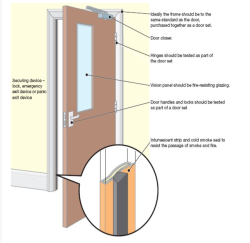Below is information to guide residents and owners on Fire Door Safety Guidance in line with the Fire Safety Act:
What is a fire door and what are they designed to do?
Fire doors are specialist doors that have been tested against the elements and are purpose-built to withstand roaring fires for as long as possible. They enable buildings to compartmentalise and delay the spread of fire from one area to another and form a crucial part of a passive fire protection strategy.
Certified fire doors will be given a fire-resistance rating, which details the length of time the door set and its materials will be able to withstand smoke and fire – either 30 or 60 minutes, depending on the rating. They are fitted with intumescent strips (or seals) that expand to fill the gap between the door and the frame.
Fire doors have a few vital safety features and really can be the difference between life and death. Two of the most important functions fire doors have are:
• When closed, they form a barrier to stop the spread of fire.
• When opened, they provide a means of escape.
What is the legal requirement for the checking of fire doors?
Under the Regulatory Reform (Fire Safety) Order 2005 (FSO), persons in control of the premises have a responsibility to ensure their properties and tenants are safe. In the first instance, the Responsible Person will arrange for a Fire Risk Assessment to be undertaken which will look closely at the fire safety arrangements as a whole, however, the responsibility extends to the arrangements for periodically checking the fire doors in blocks of flats and this includes wherever possible the entrance door to the individual flats.
In addition to the FSO, further legislation was introduced in 2023 that makes a requirement for additional fire door safety checks in blocks of flats that are greater than 11m or 5 floors in height (including ground floor). The additional provisions require communal fire doors to be checked quarterly and flat entrance doors to be checked (best endeavors) annually.
Features of fire doors
Fire doors are made up of various components. The door itself is usually made from a solid timber frame, but they can sometimes be covered again in fire-resistant glass. This glass should be able to withstand exposure to the heat condition in a fire test for at least 30 minutes before it reaches a temperature high enough to soften it.
Around the edges of the door will be the intumescent seal or intumescent strip. An intumescent seal is chemically designed to expand when temperatures reach above 100 °C to seal the gaps between the door and frame and the strip can swell up to 10 times it’s width to seal the frame. Additionally, some doors, including your flat entrance door will contain seals that have an integrated brush to stop the spread of smoke which is often prevalent in the early stages of a fire.
Fire door hinges are specially fire rated and the screws are an important part of the door set and most doors are fitted with an overhead positive self-closing device. This image demonstrates the different elements of fire safety on a door:
Fire Door Safety Do’s & Don’t’s
• Do close all doors before retiring to bed, especially any door between the lounge/kitchen and circulation hallway.
• Do check that your flat entrance door fully closes flush into the door frame under its own weight.
• Do report any damage to flat entrance or communal fire doors to RMG as soon as possible.
• Don’t replace any door with a non-fire rated door. Certification should always be provided that the door and assembly are tested to approved standards.
• Don’t paint over intumescent strips or smoke seals.
• Don’t wedge open doors.
• Don’t fit noise quietening pads to door frames. If the doors close too quickly or bang then the self-closer maybe adjusted.
FAQS
Why is an annual fire door inspection required?
The Fire Safety (England) Regulations 2022 (https://www.gov.uk/government/publications/fire-safety-england-regulations-2022) made it a legal requirement from 23 January 2023 for responsible persons (usually the Managing Agent) for all multi-occupied residential buildings in England with storeys over 11 metres in height to undertake annual checks of all flat entrance doors that lead onto a building’s common parts.
What if I live in a new build flat?
Most new build flats and doors come with a two-year warranty. The door will still need checking to ensure it meets regulations and depending on the defects found during this period this can be referred to the developer. For flats over two years old, a defect may be considered by the developer if it can be proven that the door was never compliant. However, just because a door fails it doesn’t mean that it was never compliant as doors are subject to natural wear and tear. If you have any queries on the defect found, then please reach out to your Property Manager.
What if I am about to get a new door?
Please advise the team if you are about to install a new door and we can assess the dates and the next action.
What if I am unavailable when the checks are taking place?
Unfortunately, we are only able to do the checks on the dates provided. However, If you would like to hold keys with a neighbour and/or any onsite staff (if applicable), we will happily complete the check with your written permission.
If this is not possible, we re-visit on a quarterly basis to ensure we are giving everyone another opportunity to get their door inspected. It is very important that you get this check done within the year.
If I miss your visit, what should I do?
If you miss your visit please don’t worry we will contact you within 3 months to rearrange.
What will the surveyor do inside my apartment?
Our surveyor will just need to check the inside of your front door to ensure that the self-closing device is working and that the door is in efficient working order and good repair.
How long will the visit take?
Your check should take a maximum of 5 minutes.
What if I need to contact you on the day?
Should you need to contact us on the day of your visit, please give the Apartment Door Booking team a call on 01992 801 036.
What will happen after my door check?
If there’s a problem with your door:
The owner of the property is responsible to ensure that their door meets the requirements set out under the Fire safe Regulatory Reform (Fire Safety) Order 2005 (FSO).
Residents/leaseholders have an important role to play in ensuring that, if there is a fire in their flat, the flat entrance door is an effective barrier to stop the spread of fire and smoke into the common parts.
If any hazards are identified, dependant on the Lease agreement this may be the Leaseholders responsibility to arrange for the hazards to be rectified at their cost.
If my door passes, what will happen:
If your door passes, you will not hear from us until the following year when the annual check is to be completed again.
Who is completing my check?
Your check will be carried out by representatives from the following companies:
Osterna Ltd
JLB Property Maintenance
No Letting Go
What if my property is vacant?
Regardless of whether your property is occupied or empty, you are still required by law to undertake your obligations regarding fire safety, including maintenance of fire safety equipment and we ask you to arrange access for the team to carry out the inspection.
 My RMG Living Account
My RMG Living Account
